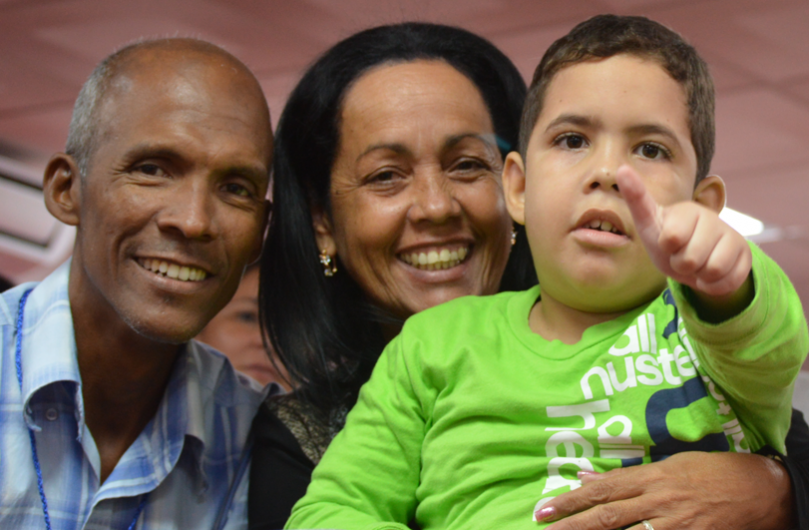Exercise for people with Prader-Willi syndrome
People with PWS are born with reduced muscle tone (which affects muscle contraction) less muscle mass and especially in childhood, weaker muscles than
non-affected people. Strong muscles are important for good movement and the protection of joints, ligaments and tendons.
Why is exercise so important for people with PWS?
Most children with PWS, develop a greater percentage of fat tissue than non-affected people, from infancy. Even when the person has a healthy weight for height (BMI) the percentage fat will be greater than in the non-affected person. This means it is much easier for them to gain fat and harder to “burn fat” through daily energy expenditure. The more muscle a person has the greater their potential for more “fat-burning” or energy expenditure, as muscle tissue burns energy (calories) first.
When people are on restricted energy intake menus, as needed by people with PWS to lose weight, there is a risk that their muscle mass will reduce as well as fat. People with PWS need to protect against muscle loss and this is only done through movement and exercise.
What can exercise do for people with PWS?
Fat loss! When we exercise we use the energy stored in our body as fat and glycogen in our muscles. Energy expenditure is naturally reduced in people with PWS, due to their reduced muscle mass. Exercise increases daily energy expenditure, both while exercising, as well as in the post exercise period. Without exercise our energy expenditure remains at a resting level, which is usually lower in people with PWS, meaning they burn fewer calories at rest.
Blood flow is increased with exercise. As we exercise our heart pumps out more blood carrying oxygen to every cell in our body, including our brain cells. Alertness improves as we breathe more deeply, filling our lungs with air and allowing increased levels of oxygen to reach our brain, through exercise. Slow deep breathing is also stress relieving. Hands and feet become warmer when exercising as blood flow is increased. This is important in PWS as peripheral blood vessels in the arms have been seen to be smaller in many adults with PWS. Increased blood flow reduces high blood pressure and exercises our heart and lungs to keep them healthy. Symptoms of sleep apnoea can, in some cases, be improved with exercise. Lymphodema is reduced through leg exercise, as the calf muscle works to pump fluid from the cells.
Bones are protected by weight, strong muscles and exercise. It is important for people with PWS to maintain a healthy weight, but if the weight is low, mainly due to strict dietary management, then bones can be at risk if the person does not have strong muscles or is not exercising regularly. Weight bearing exercise impacts on bone to increase bone density and bone strength. Strong muscles also impact on bone to increase bone density and bone strength.
Exercise can relieve stress and improve mood. Exercise also improves their self-esteem as they accomplish the set exercise task. Regular exercise provides a period of positive structure to the day, providing time to focus on a task rather than food.
Exercise naturally improves the body’s sensitivity to insulin. This is very important for people with diabetes, and pre-diabetic conditions as the increased action of the insulin will lower high blood glucose levels and improve a person’s diabetic control.
Exercise is an excellent source of sensory motor stimulation. Hypotonia in infancy leads to sensory hunger, and exercise is the best way to satisfy sensory motor needs.
When should someone with PWS start exercise?
Exercise should be started from birth and continued throughout life.
How do people with PWS respond to exercise?
Sometimes, poorly, initially, especially if they have not exercised regularly as a child. Also, they do not like to take on anything that is new to their routine or that requires effort. Exercising can be hard work at the start!
To be effective, the exercise needs to be regular. This is best achieved by making the exercise a part of their accepted routine. It is best if it can be done at the same time each day. Exercising before a meal or snack is good, but if the person suffers from regular constipation, or slower stomach emptying, exercising about 30 minutes after a meal will help. It may help to tell the person with PWS that the exercise has been prescribed by a health professional or director, to improve their fitness or strength.
Much praise is needed for effort and completion of the exercise! Praise must be genuine. They will see through false praise and likely become opposed to continuing. Start small and increase the duration or intensity very gently. Discuss the need to increase the exercise as they become fitter. Visual exercise plans or programmes will help.
Competitiveness can be a very positive tool. It is much more encouraging if you join in the exercise – eg walking with your person with PWS or competing with their efforts, for example on a treadmill. Having the person with PWS compete with themself to try to do “as good as” or “better than” the previous exercise session, or to “beat the clock” is another way of encouraging the exercise. Working towards a goal can be very helpful, especially to initiate a regular exercise pattern. That means your encouragement and support for the person with PWS to exercise must be ongoing. This can be hard, but is doable.
What is effective exercise?
Effective exercise increases your breathing rate, makes your heart beat faster and may cause sweating. By having your person with PWS walk, cycle, swim, dance or similar at an intensity that produces a “working” level they will improve their fitness, gain muscle, lose fat and have an improved mood.
What types of exercise are important for people with PWS?
Strengthening exercises
Exercising specific muscle groups will strengthen muscles and increase the number of muscle fibres to build bigger muscles. These exercises can be done with weights to have a better effect on strength. They are repetitive movements of the muscle. As the muscle becomes stronger the number of repetitions is increased.
Aerobic exercise
To improve the fitness of our heart and lungs as well as “burn” energy (calories), exercise must be of an aerobic nature. When exercising aerobically we take in more oxygen and use large muscle groups, usually involving the whole body for a continual movement. Examples of aerobic exercise are walking or dancing or swimming or cycling.
How to start
It is important to match the exercise to the person’s own ability and current level of physical activity.
If your person with PWS is doing no exercise and you know they are hard to motivate, start slowly. Small breaks may be required by some people, when getting started. Talk with them about the idea of starting an exercise regimen to make them strong and improve their fitness. It also helps to offer an incentive or some competition, for example, you might suggest to them “Let’s see if I can keep up with you when you exercise”
Suggesting an appropriate reward may also help get them motivated; “If you can cycle for 10 minutes on 3 days each week, you may have an extra 15 minutes at the park on Saturday.” Using a visual chart to record progress and rewards can be very motivating.
It is very important to have someone supervise or join them in the exercise due to poor body orientation and sensation, and to ensure it is completed effectively You, or someone else, could tell them you (or someone else) also wants to get fit and will join them to see who can do the best. When initiating an exercise program for someone who is not particularly active they may start by exercising for 10-15 minutes 3 times per week, then increase the time up to 30-60 minutes, 5-6 days per week. Exercise will decrease your stress as well! However, to maintain the regularity of exercise for your person with PWS, seek assistance from others who can step in to accompany them when you are not able to or just want a break.
When a person with PWS is exercising regularly and effectively they may reach a stage where extra energy intake is indicated. One additional serve of protein can be included in their regular, restricted food intake. For example, one extra slice of lean meat or chicken could be added to their usual lunchtime sandwich, if they continue to lose weight.
How much exercise is enough?
For the general population, doctors recommend one hour per day to maintain body weight and for cardiovascular fitness. For weight loss, doctors recommend 2 hours per day. Do people with PWS need to do this much exercise? Some may, when their fitness greatly improves, but we must be mindful of each individual’s musculoskeletal condition at the age they commence effective, regular exercise.
This article was written by IPWSO’s Famcare Board.


International Community
IPWSO was established so that PWS associations, families, clinicians and caregivers around the world could exchange information and support and have a united global voice under one umbrella.
Information for Medical Professionals
The latest medical and scientific research and information, plus guides into common medical issues affecting people with PWS.



